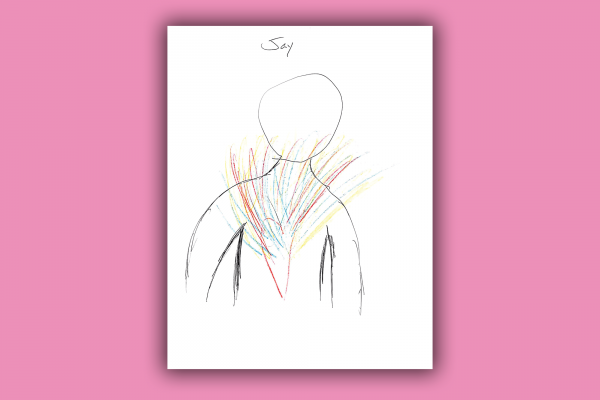IT'S LONG BEEN known that empathy may be inherent in portraiture—walking a mile in the shoes of one’s painting subject. As the renowned 15th-century painter and monk Fra Angelico put it, “He who wishes to paint Christ’s story must live with Christ.” New research reinforces this association between artmaking and spirituality.
A 2020 Fetzer Institute study of U.S. spirituality, which includes 16 focus groups and 26 in-depth interviews, reports that more than 80 percent of its 3,600 respondents self-identified as somewhat spiritual, and about 60 percent aspired to be more spiritual. Novelly, researchers used drawings as an “inductive research tool” to understand better what respondents meant by “spirituality,” said Veronica Selzler, lead author of the Fetzer study and strategy director at Hattaway Communications in Washington, D.C. Art allowed participants to define spirituality creatively rather than prescriptively. “It was through these drawings that the diversity and common threads began to emerge,” she said.
The study reproduced 38 drawings in which respondents, aged 18 to 71, interpreted spirituality. The “slightly spiritual/not religious at all” Dale, 69, drew five clouds—one perhaps smiling—and grass as his “happy place, but you could call it a spiritual place.” Daniel, 20, who is “very spiritual/not at all religious,” drew a self-portrait praying on his knees before Jesus.
Respondents offered more “tradition-centric” views when asked to write “top-of-mind thoughts” about spirituality compared to drawing the same. Drawings “gave research participants a new tool to articulate an idea that many had never considered or put words to before,” Selzler said. “People are bound by the language they have to talk about big ideas such as spirituality.”
By poring over drawings, researchers could transcend “an artificial dichotomy between religion and spirituality that a close-ended question can’t fully capture,” Selzler said. The study also found half of respondents engage in art—including painting, singing, and listening to music—as spiritual practice at least weekly, second only in the study to the rate of prayer.
This—and the study’s focus group findings that associate spirituality with empathy—are consistent with what Ashlee Whitaker, Brigham Young University Museum of Art’s curator of religious art, has observed. (Whitaker wasn’t involved in the study, but BYU’s museum rewrote its mission and vision statements recently to emphasize empathy as a key motivator.)
“Visual arts offer a new language in which to convey the spiritual and sacred in human experience,” she said. “Rather than letters, words, rhyme, symbolic meter, they employ line, color, shade, textures to offer up expressions of the ineffable in a form of communication that can transcend language, geography, and cultures.”
Visual arts also foster mutual understanding. “We are realizing that more and more, art can be a tool for empathy in an era where it is much needed,” Whitaker said. “An image can do so much that text and speaking cannot.”
“Art is an access point to the soul,” she added. “It opens us up to feel another’s deep experiences.”
To Elif Gokcigdem, author of the books Fostering Empathy Through Museums and Designing for Empathy: Perspectives on the Museum Experience (for which I co-authored a chapter), empathy involves mirror neurons in the brain attuning to emotions and feelings that art can express creatively.
“Artists often use emotional experiences in their art as inspiration, while at the same time also aiming to evoke an emotional response in the viewer,” she said. “Through its connections to emotions, art then becomes the perfect tool to explore empathy.”
But, to Gokcigdem, empathy isn’t an automatic outcome of making or experiencing art. Sociocultural and economic background and worldview, as well as effort and an open mind, can affect one’s understanding and empathetic choices.
Gokcigdem associates the sacred with the wholeness of humanity and the planet. She finds meaning in geometric patterns of Islamic art and architecture. “They represent the oneness of all beings,” she said. “I cannot think of empathy without the context of oneness; in a way, empathy for me is a way to explore my interconnectedness with this whole, or One.”
When she looks at a tile-covered dome, whose design suggests interconnected star constellations, Gokcigdem imagines the intricate ensemble’s origin as a seemingly insignificant dot on a piece of paper that birthed lines, shapes, stars, and the entire design, appearing to have no beginning or end. She envisions herself at the center.
“I imagine extending my arms and whirling like a compass, one foot on this central point, hands reaching out to touch all the dots that collectively form a circle around me, my circle,” she said. “From my vantage point, I can only see my circle and perhaps a few that are around me, but when I look at myself from the perspective of the whole, my humble stature becomes essential, and meaningful as part of a greater whole.”
Locating herself within sacred artwork, Gokcigdem believes she’s situated perfectly to probe and respect others’ perspectives. “Museums encourage us to understand, emotionally engage with, and contemplate this profound truth, and help us to become more responsive to the needs of those around us and of our environment,” she said.

Got something to say about what you're reading? We value your feedback!







